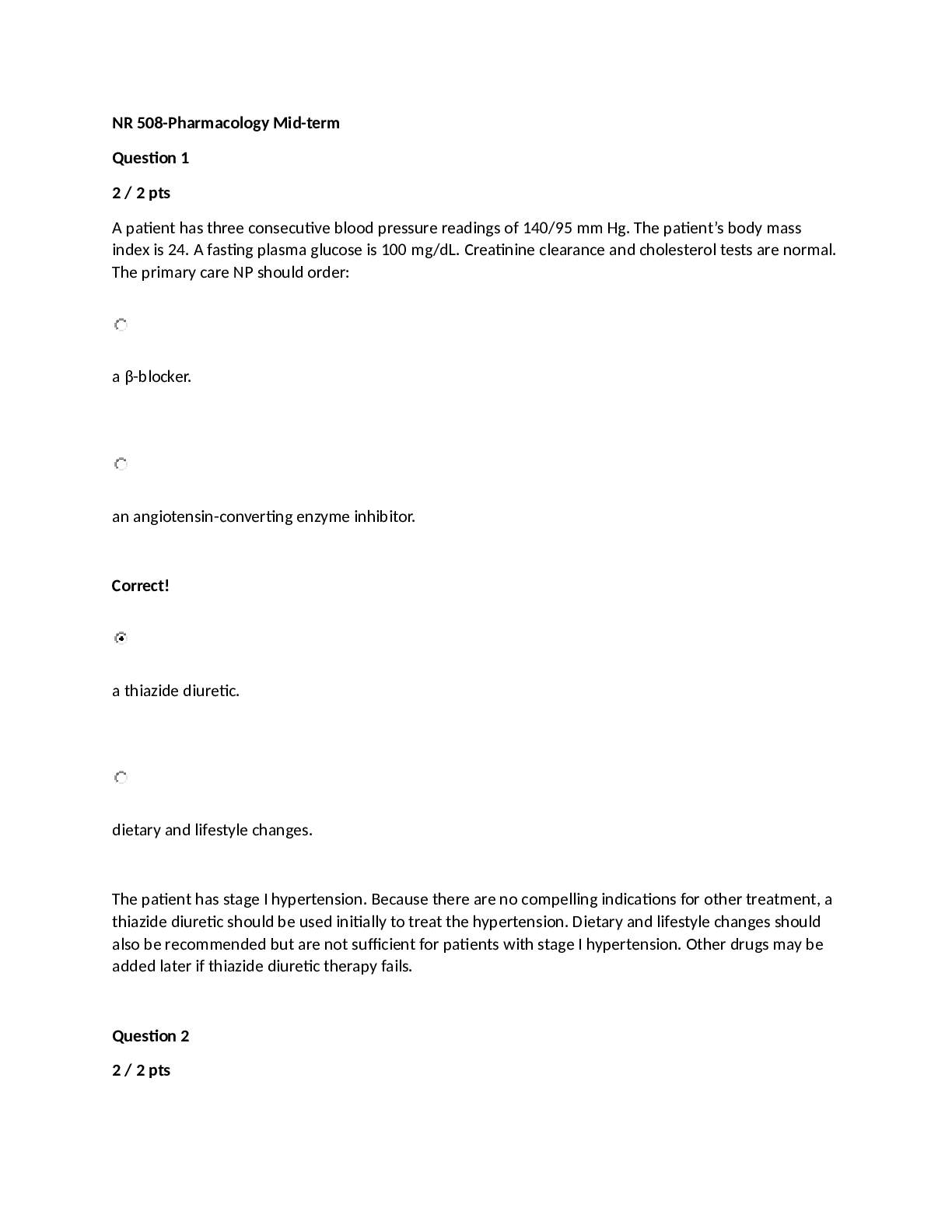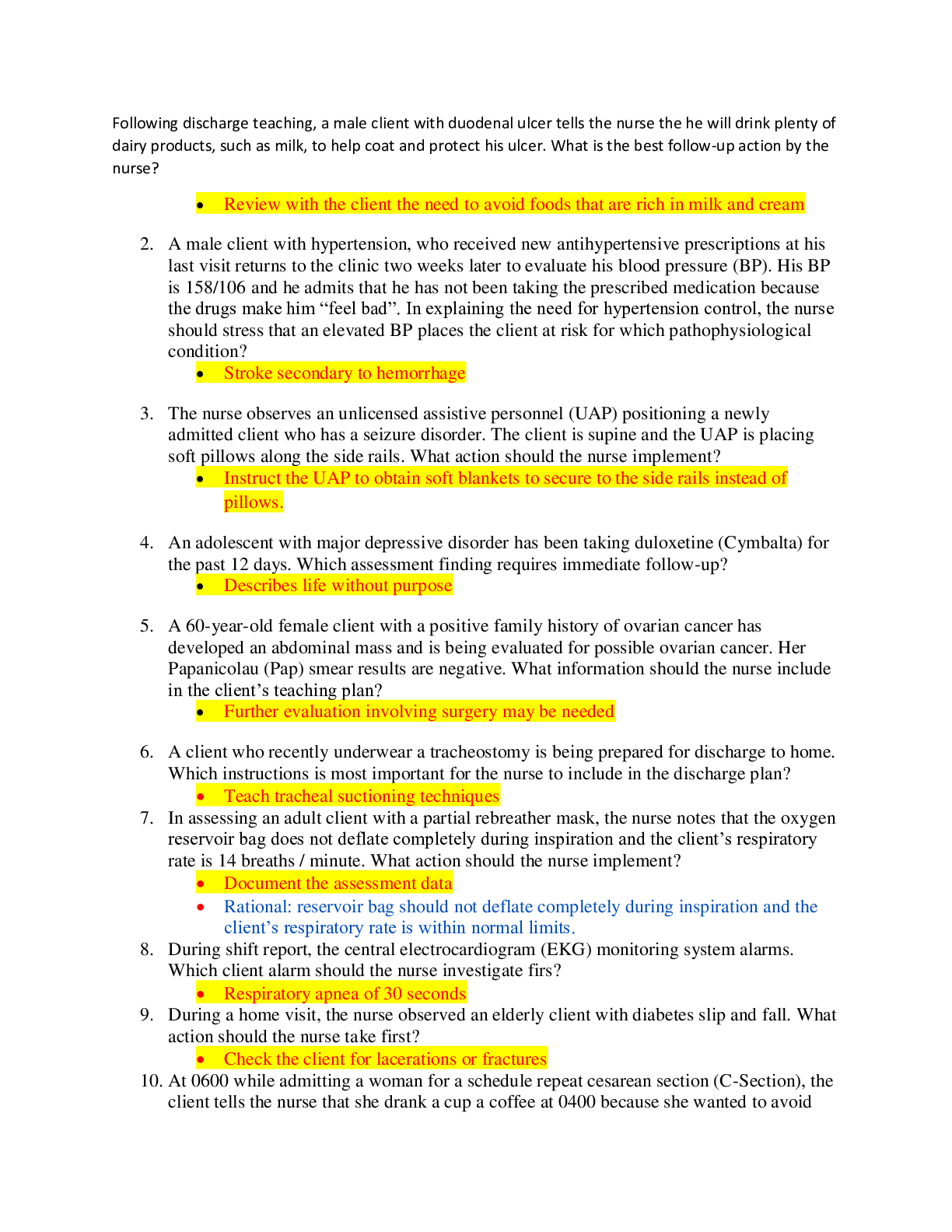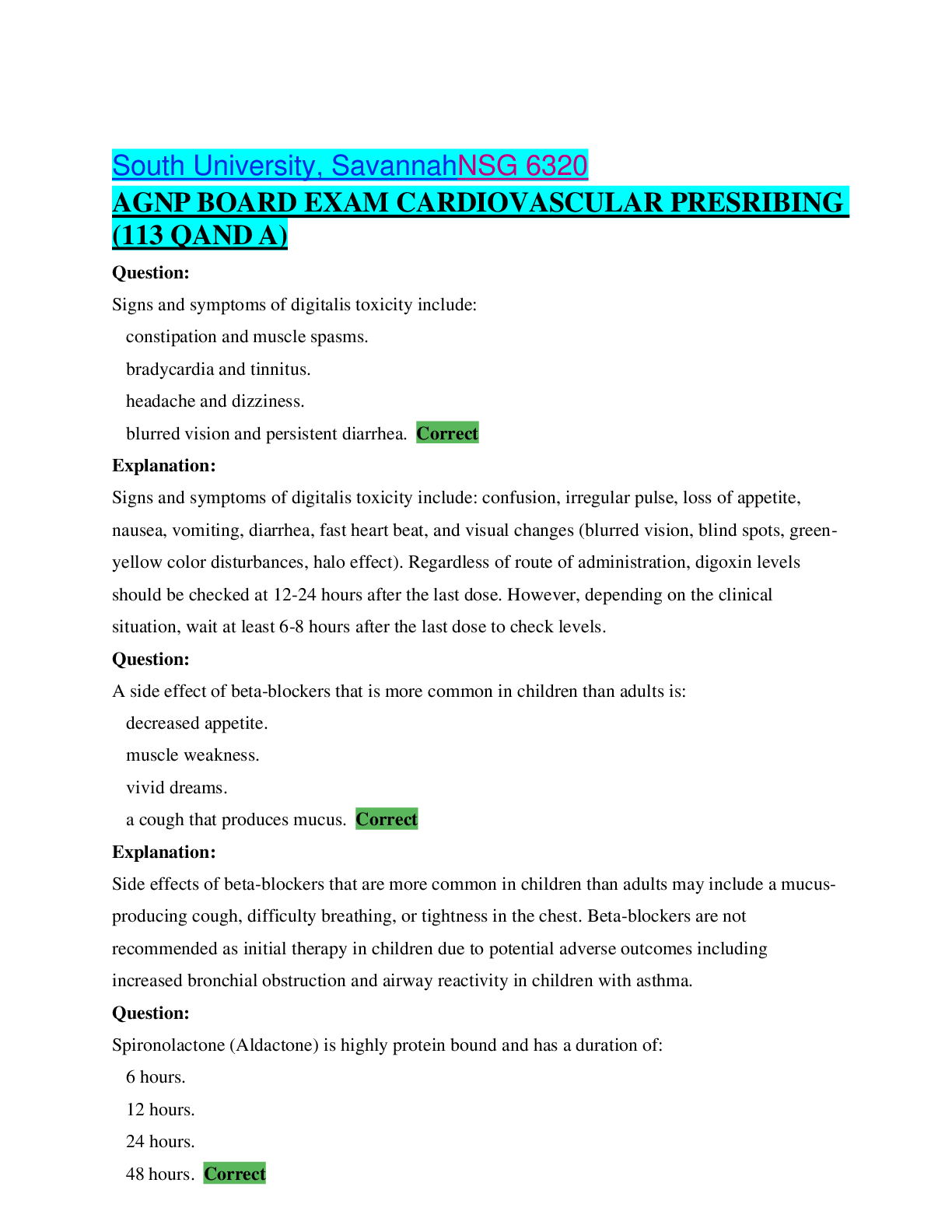NSG 6320 AGNP BOARD EXAM QUESTIONS EYE EAR NOSE THROAT Assessment. 2020.
Document Content and Description Below
AGNP BOARD EXAM QUESTIONS Assessment Eye, Ear, Nose and Throat (166 Questions) Question: Ophthalmoscopic examination of the fundus reveals small, rounded, slightly irregular red spots embedded in ... the retina. These findings are consistent with: superficial retinal hemorrhages. preretinal hemorrhages. microaneurysms. deep retinal hemorrhages. Correct Explanation: Deep retinal hemorrhages appear as small, rounded, slightly irregular red spots and are sometimes called dot or blot hemorrhages. They occur in a deeper layer of the retina than flameshaped hemorrhages. Diabetes is a common cause. Superficial retinal hemorrhages appear as small, linear, flame-shaped, red streaks in the fundi and are seen in hypertension, papilledema, and occlusion of the retinal vein. Preretinal hemorrhages lie anteriorly between the retina and the vitreous and are typically larger than retinal hemorrhages. These hemorrhages obscure any underlying retinal vessel. Microaneurysms present as tiny, round, red spots commonly seen in and around the macular area. These are classic in diabetic retinopathy. Question: The whispered voice test allows the examiner to screen for: low frequency hearing loss. high frequency hearing loss. general hearing loss. Correct conductive hearing loss. Explanation: The whispered voice test for auditory acuity and allows the examiner to screen for general hearing loss. In the elderly who have presbycusis, high frequency hearing loss is present. Since consonants are higher frequency sounds than vowels, these sounds are often missed. Question: On examination of the tympanic membrane, a red bulging ear drum is detected. This is consistent with: acute otitis externa. chronic otitis externa. acute otitis media. Correct a serous effusion. Explanation: A red bulging tympanic membrane may be found in a patient who has acute otitis media. In acute otitis externa, the canal may be swollen, narrow, moist and pale with tenderness on touching. The ear drum is intact. In chronic otitis externa, the skin of the canal may be thickened, red, and pruritic. The ear drum is usually unaffected. With serous effusion the ear drum appears amber and there usually is no bulging of the eardrum. Question: One of the refractive errors of vision that presents with symptoms of blurriness and improved with corrective lens, is known as: hyperopia. myopia. strabismus. astigmatism. Correct Explanation: Myopia, nearsightedness, occurs when light rays focus anterior to the retina. Hyperopia, farsightedness, occurs when light rays focus posterior to the retina. Strabismus, heterotropia, is a condition in which the eyes are not properly aligned with each other. In astigmatism, light rays do not focus correctly on the retina. This causes blurriness. Question: Miosis is a term used to describe: the shape of the pupils. constriction of the pupils. Correct dilation of the pupils. symmetry of the pupils. Explanation: Miosis refers to constriction of the pupils, mydriasis refers to dilation. Miosis is not associated with the shape or symmetry of the pupils. Question: Otosclerosis is an example of a(n): conductive hearing loss. Correct sensorineural hearing loss. mixed hearing loss. acquired hearing loss. Explanation: Otosclerosis is a hereditary disorder of the labyrinthine capsule in which abnormal bone growth occurs around the ossicles resulting in fixation of the stapes. The stapes does not vibrate which reduces sound transmission to the inner ear. This produces a conductive hearing loss. Question: Drooping of the upper eyelid is termed: an epicanthal fold. ptosis. Correct a retracted lid. ectropion. Explanation: Ptosis is a drooping of the upper eyelid and can be caused by myasthenia gravis, damage to the oculomotor nerve, or to the sympathetic nerve supply (Horner's syndrome). A weakened muscle, relaxed tissues, and the weight of herniated fat may cause senile ptosis. Ptosis can also be congenital. An epicanthal fold is a vertical fold of skin that lies over the medial canthus. A retracted lid is seen as a wide eyed stare. Ectropion is seen when the lower lid turns outward and exposes the palpebral conjunctiva. Question: When a light beam shines into one pupil causing pupillary constriction in that eye, the term used is: indirect reaction to light. consensual reaction to light. optic radiation. direct reaction to light. Correct Explanation: The pupils of both eyes respond identically to a light stimulus regardless of which eye has been stimulated. The direct response describes light entering one eye that produces constriction of the pupil of that eye. A consensual response describes constriction of the unstimulated pupil. These reactions should be compared in both eyes and if there is a difference, further investigation is warranted. Optic radiation is a term used to describe the tract that nerve impulses follow through the retina, optic nerve, and optic tract. [Show More]
Last updated: 2 years ago
Preview 1 out of 68 pages

Buy this document to get the full access instantly
Instant Download Access after purchase
Buy NowInstant download
We Accept:

Reviews( 0 )
$15.00
Can't find what you want? Try our AI powered Search
Document information
Connected school, study & course
About the document
Uploaded On
Jan 26, 2021
Number of pages
68
Written in
Additional information
This document has been written for:
Uploaded
Jan 26, 2021
Downloads
0
Views
80











; Answered.png)




 – South University Savannah.png)
 - Prescription (102 Questions) – South University Savannah.png)
 _ Dermatology Prescription (100 Questions and Answers) – South University Savannah.png)
 Assessment question of Endocrinology (48 Questions) – South University Savannah.png)
 Dermatology (64 questions and answers) – South University Savannah.png)
 Prescription Gastroenterology (85 Questions) – South University Savannah.png)
 Prescription of Endocrinology (89 Questions) – South University Savannah.png)
 Assessment Eye, Ear, Nose and Throat (166 Questions) – South University Savannah.png)
 Cardiovascular Assessment (107 Questions and Answers) – South university Savannah.png)

